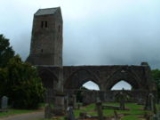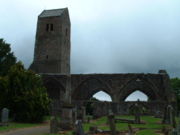
Muthill
Encyclopedia
Muthill, pronounced [ˈmjuːθɪl], is a village in Perth and Kinross
, Perthshire
, Scotland. It lies on the former railway line connecting Perth
and Crieff
, 3 miles south of Crieff. The name possibly derives from Moot hill
, a place of judgement.
The ancient village was once an important religious centre and the site of a Celí Dé
monastery. The church here also served for a time as a seat of the Bishops of Strathearn
(later Dunblane
) before the building of the cathedral at Dunblane in the 13th century.
 The village was largely destroyed in the 1715 – 1716 Jacobite rising
The village was largely destroyed in the 1715 – 1716 Jacobite rising
, by Jacobite troops retiring after their defeat at the Battle of Sheriffmuir
, being rebuilt in the 1740s as it lay on the route of General Wade
's military road through Strathearn.
There are over a hundred listed buildings in the village. The kirkyard at the centre of the small town contains the ruins of an important 15th century parish church, which incorporates an 11th century bell-tower (originally free-standing, and comparable to, though on a smaller scale than, that incorporated into Dunblane Cathedral
), built on the orders of Michael Ochiltree
, Bishop of Dunblane
(in the care of Historic Scotland
; no entrance charge). This is almost the only visible reminder of the ancient village. An early Christian cross-slab (perhaps 10th-11th century) and a damaged 13th century double effigy of an Earl and Countess of Strathearn (formerly within the choir of the church) are preserved within the tower.
Muthill Primary School serves the village. There is no secondary school.
In 2011, Muthill embarked upon a Community Action Plan exercise to explore how people envisaged the development of the village.
Perth and Kinross
Perth and Kinross is one of 32 council areas in Scotland, and a Lieutenancy Area. It borders onto the Aberdeenshire, Angus, Dundee City, Fife, Clackmannanshire, Stirling, Argyll and Bute and Highland council areas. Perth is the administrative centre...
, Perthshire
Perthshire
Perthshire, officially the County of Perth , is a registration county in central Scotland. It extends from Strathmore in the east, to the Pass of Drumochter in the north, Rannoch Moor and Ben Lui in the west, and Aberfoyle in the south...
, Scotland. It lies on the former railway line connecting Perth
Perth, Scotland
Perth is a town and former city and royal burgh in central Scotland. Located on the banks of the River Tay, it is the administrative centre of Perth and Kinross council area and the historic county town of Perthshire...
and Crieff
Crieff
Crieff is a market town in Perth and Kinross, Scotland. It lies on the A85 road between Perth and Crianlarich and also lies on the A822 between Greenloaning and Aberfeldy. The A822 joins onto the A823 which leads to Dunfermline....
, 3 miles south of Crieff. The name possibly derives from Moot hill
Moot hill
A moot hill or mons placiti is a hill or mound historically used as an assembly or meeting place. In early medieval Britain, such hills were used for "moots", meetings of local people to settle local business. Among other things, proclamations might be read; decisions might be taken; court cases...
, a place of judgement.
The ancient village was once an important religious centre and the site of a Celí Dé
Culdee
Céli Dé or Culdees were originally members of ascetic Christian monastic and eremitical communities of Ireland, Scotland and England in the Middle Ages. The term is used of St. John the Apostle, of a missioner from abroad recorded in the Annals of the Four Masters at the year 806, and of Óengus...
monastery. The church here also served for a time as a seat of the Bishops of Strathearn
Strathearn
Strathearn or Strath Earn is the strath of the River Earn, in Scotland. It extends from Loch Earn in Perth and Kinross to the River Tay....
(later Dunblane
Dunblane
Dunblane is a small cathedral city and former burgh north of Stirling in the Stirling council area of Scotland. The town is situated off the A9 road, on the way north to Perth. Its main landmark is Dunblane Cathedral and the Allan Water runs through the town centre, with the Cathedral and the High...
) before the building of the cathedral at Dunblane in the 13th century.

Jacobite rising
The Jacobite Risings were a series of uprisings, rebellions, and wars in Great Britain and Ireland occurring between 1688 and 1746. The uprisings were aimed at returning James VII of Scotland and II of England, and later his descendants of the House of Stuart, to the throne after he was deposed by...
, by Jacobite troops retiring after their defeat at the Battle of Sheriffmuir
Battle of Sheriffmuir
The Battle of Sheriffmuir was an engagement in 1715 at the height of the Jacobite rebellion in England and Scotland.-History:John Erskine, 6th Earl of Mar, standard-bearer for the Jacobite cause in Scotland, mustered Highland chiefs, and on 6 September declared James Francis Edward Stuart as King...
, being rebuilt in the 1740s as it lay on the route of General Wade
George Wade
Field Marshal George Wade served as a British military commander and Commander-in-Chief of the Forces.-Early career:Wade, born in Kilavally, Westmeath in Ireland, was commissioned into the Earl of Bath's Regiment in 1690 and served in Flanders in 1692, during the Nine Years War, earning a...
's military road through Strathearn.
There are over a hundred listed buildings in the village. The kirkyard at the centre of the small town contains the ruins of an important 15th century parish church, which incorporates an 11th century bell-tower (originally free-standing, and comparable to, though on a smaller scale than, that incorporated into Dunblane Cathedral
Dunblane Cathedral
Dunblane Cathedral is the larger of the two Church of Scotland parish churches serving Dunblane, near the city of Stirling, in central Scotland.-History:...
), built on the orders of Michael Ochiltree
Michael Ochiltree
Michael Ochiltree [Ouchtre] was a 15th century Scottish prelate and administrator. A close associate of King James I of Scotland, from the late 1410s he rose in rank from canon to Dean of Dunblane and then Bishop of Dunblane...
, Bishop of Dunblane
Bishop of Dunblane
The Bishop of Dunblane or Bishop of Strathearn was the ecclesiastical head of the Diocese of Dunblane/Strathearn, one of medieval Scotland's thirteen bishoprics. It was based at Dunblane Cathedral, now a parish church of the Church of Scotland. The bishopric itself certainly derives from an older...
(in the care of Historic Scotland
Historic Scotland
Historic Scotland is an executive agency of the Scottish Government, responsible for historic monuments in Scotland.-Role:As its website states:...
; no entrance charge). This is almost the only visible reminder of the ancient village. An early Christian cross-slab (perhaps 10th-11th century) and a damaged 13th century double effigy of an Earl and Countess of Strathearn (formerly within the choir of the church) are preserved within the tower.
Muthill Primary School serves the village. There is no secondary school.
In 2011, Muthill embarked upon a Community Action Plan exercise to explore how people envisaged the development of the village.

